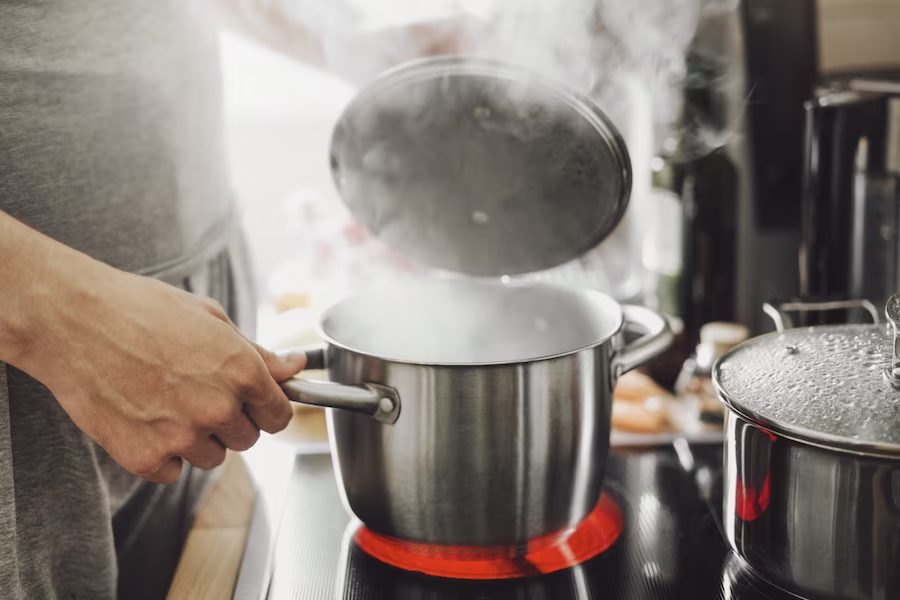The universe of culinary arts abounds with various terminologies and cooking techniques, each playing a pivotal role in transforming raw ingredients into palatable meals. Among these myriad terminologies is ‘Rapid Boiling’, a term prevalent in kitchen lingo, integral to an array of cooking tasks. This elaborate article aims to dissect the intricacies of rapid boiling, its scientific underpinnings, implications, comparative analysis, practical application tips, and some commonly asked questions to dispel potential misconceptions.
Defining Rapid Boiling: A Scientific Perspective
Rapid boiling is a culinary term referring to the process of heating a liquid, typically water, to its boiling point where it bubbles vigorously and consistently. This point is generally recognized at around 212 degrees Fahrenheit (100 degrees Celsius) at sea level. It signifies a state of intense thermal energy causing water molecules to break their bonds and convert into a gaseous state, leading to the production of continuous large bubbles.
The advent of this phenomenon in cooking happens through the transfer of heat from a stove or other heat source, which gradually increases the temperature of the water in the pot, culminating in rapid boiling. It is essential to note that the altitude, atmospheric pressure, and the purity of the water can affect the precise boiling point.
Dissecting Boiling: Simmering, Slow Boiling, and Rapid Boiling
Understanding the different stages of boiling, namely simmering, slow boiling, and rapid boiling, is key to mastering various culinary practices.
- Simmering: This is the initial stage where small bubbles form at the bottom of the pot and slowly ascend to the surface, but the overall liquid temperature remains lower than the boiling point. Simmering is usually maintained at a temperature range of 185-200°F (85-93°C).
- Slow Boiling: Progressing from simmering, slow boiling marks the stage where larger bubbles make their way to the surface slowly, breaking intermittently, with moderate steam starting to appear. The temperature range here is approximately 205-212°F (96-100°C).
- Rapid Boiling: The pinnacle of this progression is rapid boiling, characterized by vigorous, large, continuous bubbles, with a considerable amount of steam. The liquid temperature at this stage is 212°F (100°C) at sea level.
It’s important to highlight that these stages aren’t just academic but carry practical implications in cooking different dishes and using various ingredients. For instance, delicate items like fish and certain vegetables might call for simmering, while pasta and hard-boiled eggs typically require a full, rapid boil.
Rapid Boiling: Practical Implications
Like any cooking technique, rapid boiling too has its strengths and limitations, and understanding them can significantly enhance the cooking process:
Positive Implications
- Speed: Rapid boiling facilitates faster cooking as compared to simmering or slow boiling. For culinary enthusiasts pressed for time, it’s a perfect way to speed things up.
- Food Preparation: Many foods, particularly those with a robust structure like pasta or root vegetables, require the intense heat of rapid boiling to cook through properly.
- Evaporation: In culinary tasks where the reduction of a liquid is needed, like making a stock or sauce, rapid boiling can help speed up the evaporation process.
Negative Implications
- Overcooking: Due to the high heat, rapid boiling can lead to overcooked or tough food, especially if dealing with delicate ingredients like fish or green leafy vegetables.
- Nutrient Loss: Certain nutrients, notably the water-soluble vitamins like vitamin C and some B vitamins, can leach into the water during rapid boiling, leading to nutritional loss.
- Safety Hazards: The vigorous bubbling during rapid boiling can lead to splashing of hot water, posing a risk of burns. Moreover, if left unattended, the pot could boil dry, posing a fire hazard.
Mastering Rapid Boiling: A Practical Guide
Achieving the perfect rapid boil and using it effectively in cooking necessitates following some key best practices:
- Right Equipment: Opt for a pot or kettle with a thick, heavy bottom that promotes even heat distribution;
- Water Level: Fill the pot with enough water to allow the food to move freely. This ensures even cooking and prevents the water from evaporating too quickly;
- Heat Source: Start with high heat to bring the water to a rapid boil quickly. Once the desired stage is achieved, adjust the heat as needed;
- Using a Lid: A lid helps to trap the heat, accelerating the boiling process. However, once boiling, it’s better to partially or completely remove the lid to prevent boiling over;
- Stirring: For foods like pasta, stir occasionally during rapid boiling to prevent sticking;
- Seasoning: Add salt after the water has started boiling to prevent damage to your pot and enhance the flavor of the food.
Conclusion
Rapid boiling is a critical culinary technique, and a thorough understanding of its aspects can profoundly enhance the quality of the dishes you create. Although it has its own set of challenges, with the correct knowledge and practice, rapid boiling can be harnessed effectively, making it an invaluable asset in any cooking repertoire.
FAQ
Yes, due to the higher temperature involved, rapid boiling can cook food faster than slow boiling.
No, rapid boiling is not ideal for all food types. Delicate foods can lose their texture and taste, while some foods may become tough or rubbery.
Both rapid and slow boiling can kill bacteria effectively as long as the temperature is at or above 212°F (100°C), which is above the heat tolerance for most bacteria.
Yes, but care should be taken not to boil dry, as this could damage the non-stick coating and create harmful fumes.
